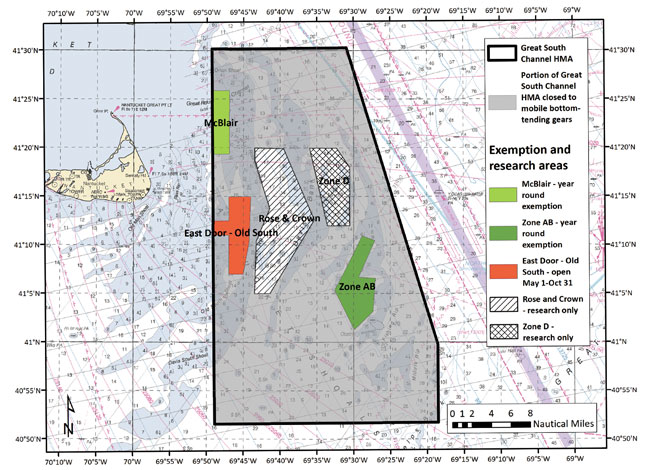Council Supports Surfclam, Mussel Fishery Access to Certain Areas Within Great South Channel HMA

The Great South Channel Habitat Management Area with sub-areas identified in the Council’s Clam Dredge Framework for surfclam and mussel fishing and further research. – NEFMC graphic
The New England Fishery Management Council has signed off on new measures that will allow surfclam fishermen to continue fishing within strictly defined boundaries inside the Great South Channel Habitat Management Area (HMA). Increased monitoring provisions will apply. Mussel fishermen also will be able to fish in the new areas. The measures are included in the Council’s Clam Dredge Framework, which is a trailing action to Omnibus Essential Fish Habitat (EFH) Amendment 2, often referred to as OHA2.
The amendment was implemented April 9, 2018 and prohibited the use of mobile bottom-tending gear within the HMA. However, the surfclam fishery was granted a one-year exemption to continue operating in all but the northeast corner of the area. This exemption expires April 9, 2019. If the National Marine Fisheries Service (NMFS, NOAA Fisheries) approves and implements the Clam Dredge Framework, surfclam and mussel fishermen will be granted long-term exemptions under certain restrictions for the following sub- areas:
• McBlair – Year round;
• Zone AB – Year round; and
• East Door/Old South – seasonally from May 1 through October 31.
In addition, the Habitat Plan Development Team (PDT) will work with industry to prioritize research needs for two other sub-areas:
• Rose and Crown; and
• Zone D.
Once prioritized research needs are identified for Rose and Crown and Zone D, the Council’s intent is that fishermen and researchers will work collaboratively toward obtaining exempted fishing permits for these sub-areas to better define where concentrations of surfclams can be harvested without disturbing sensitive habitat. The Council said this research potentially could lead to the development of additional exemptions in the future.
Monitoring Provisions
As part of the Clam Dredge Framework, the Council adopted a list of monitoring provisions that would apply to vessels fishing in the newly defined exemption areas. The provisions, which were recommended by the Council’s Enforcement Committee, are as follows.
• Fishermen must request to be part of the exemption program, and vessels likely will be issued an annual letter of authorization.
• Vessels must declare into the Great South Channel Habitat Management Area fishery on each trip.
• Participating vessels must submit vessel monitoring system (VMS) positions every five minutes within three nautical miles of the Great South Channel HMA and when inside the HMA.
• Participants in the exemption program will be allowed to fish in multiple HMA exemption areas per trip but dredges must be on deck when transiting between areas.
• Mussel fishermen will be restricted to using dredges with a maximum width of eight feet. And,
• Vessels targeting mussels in the HMA exemption areas may not fish for, possess, or land any species other than mussels, consistent with requirements within the existing mussel/urchin dredge exemption area.
Industry members urged the Council to adopt Rose and Crown and Zone D as exemption areas instead of research areas. And, the Council began its deliberations with a motion that would have taken this path.
However, after extensive debate, the Council instead settled on a compromise position between protecting sensitive bottom within the Great South Channel Habitat Management Area and allowing fishing activities to continue. In fact, the Council’s “Statement of Work” for the Clam Dredge Framework reads as follows:
“The surfclam fishery will be granted a one-year exemption for the Great South Channel Habitat Management Area (GSC HMA) following implementation of OHA2, which will allow NEFMC to consider development of an access program for this fishery.
The Council intends through this action to identify areas within the HMA that are currently fished or contain high energy sand and gravel that could be suitable for a hydraulic clam dredging exemption that balances achieving optimum yield for the surfclam fishery with the requirement to minimize adverse fishing effects on habitat to the extent practicable and is consistent with the underlying objectives of OHA2.”
What’s Next?
Now that the Council has signed off on the Clam Dredge Framework, staff, working with the Habitat PDT, will finalize the document and submit it to NMFS/NOAA Fisheries for approval and implementation.
The Council recognized that the timing is tight. The current one-year exemption for the surfclam fishery in the Great South Channel HMA expires on April 9, 2019, and it is highly unlikely that the Clam Dredge Framework will be implemented in early April. Therefore, in all reality, surfclam fishermen will be prohibited from fishing in the HMA from April 10, 2019 until the new framework is in place.
The Council discussed options to address this gap and debated the possibility of developing a separate framework to extend the original exemption. In the end, however, the Council concluded that developing a second action would only delay work on the Clam Dredge Framework and further extend the timeframe for when a final rule could be implemented.
For more information, contact Michelle Bachman, the Council’s habitat coordinator, at (978) 465-0492, ext. 120, mbachman@nefmc.org.
All habitat-related materials used during the Council’s September 2018 meeting can be found at Habitat Report. Also visit September 24-27, 2018 NEFMC meeting, Plymouth, MA.
